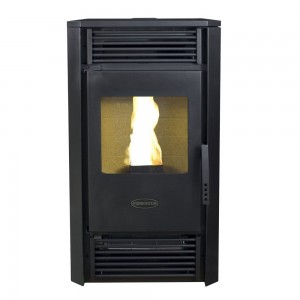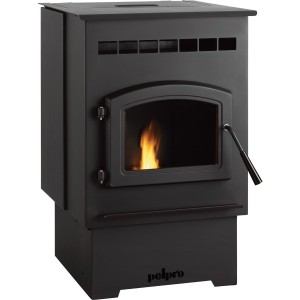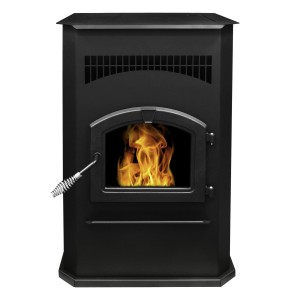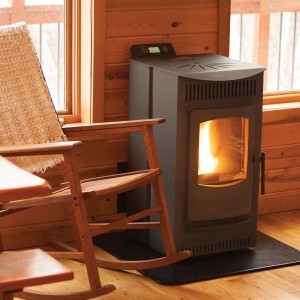Thinking of buying a reliable home heating stove? A pellet stove may be your best bet. Pellet stoves burn compressed biomass or wood pellets to produce heat. The pellets are stored in a hopper (storage container), which makes it possible to feed the stove steadily. Because of this, a constant flame is guaranteed with little or no adjustments.
Check Out The Best Pellet Stoves Reviewed By Our Experts
| Name | Rating | Statistics | Link | |
|---|---|---|---|---|
| 1 |
US Stove R5824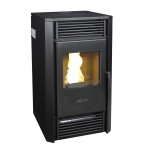
|
Read review |
Features
Design
Efficiency
Durability
Value for money
|
Check Availability |
| 2 |
Castle 12327 Serenity
|
Read review |
Features
Design
Efficiency
Durability
Value for money
|
Check Availability |
| 3 |
Pleasant Hearth Cabinet Style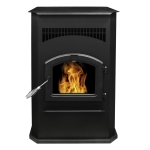
|
Read review |
Features
Design
Efficiency
Durability
Value for money
|
Check Availability |
| 4 |
Pelpro Pellet Stove Model PP60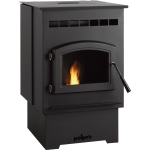
|
Read review |
Features
Design
Efficiency
Durability
Value for money
|
Check Availability |
Buying Guide And Recommended Pellet Stoves
Are you still thinking about if a pellet stove is the right product for your home? We provide you with valuable information about pellet stoves and what to consider when finding the right stove for your home.
Contents
What Is Great About The Pellet Stove?
The best pellet stoves look similar to fireplace inserts or wood stoves, but that’s all they have in common. Instead of using firewood as a fuel, these stoves use small pellets made from recycled sawdust, wood shavings or corn. These stoves produce small fires but burn very high heat content. This makes it more convenient to run and its efficiency is much higher. These stoves have a combustion efficiency ranging between 78-85%. In terms of heating capacity, the stoves’ capacities range from 8,000 to 90,000 BTUs/Hour. This is an incredible range, making pellet stoves very convenient for all types of homes.
To better understand why the pellet stoves are incredibly reliable, it is helpful to learn more about wood pellets. Wood pellets, wood’s compressed industrial waste, are a great source of energy given that they easily undergo combustion and produce huge amounts of heat energy. Each wood pellet measures about 15 to 20 millimeters in length and 6 to 8 millimeters in width. During their production, these pellets go through high compaction, which makes them extremely dense. This compaction is so dense that unlike wood, the pellets would sink in water. In addition to being dense, wood pellets contain less that 10% of moisture content. However, proper storage is necessary, as the pellets are highly hygroscopic.
Pellet stoves are slowly edging out other stoves from the market. This transition is largely due to pellet stoves being a greener alternative. Pellet stoves produce so little pollution that they do not even require EPA certification. They create no creosote and fall perfectly within clean air standards, proving to be a great choice of stove for the environmentally conscious. By using pellets instead of timber, pellet stoves also help prevent the reduction of forest cover, a growing concern for the environment.
Pellet stoves are fully automated. The stove’s thermostat detects when the room is too cold and requires heating. The stove then feeds wood pellets to the burner, and heat is produced. Once the room is fully heated, the stove goes off, saving you the trouble of lighting the stove every time you need to heat up the room. All that is left for you is to collect the ash. The ease of operation and efficiency seen in pellet stoves have made them rank among the best stoves. Many homeowners are going for these stoves, and the fact that they can be used in any home setup makes them very reliable.
The Benefits Of Using A Pellet Stove
Safety
One of the major benefits that you will enjoy from using a pellet stove is their safety. These stoves are very safe considering that they always maintain a cool exterior surface. Unlike wood burning stoves that radiate heat through their walls, pellet stoves do not conduct heat. Instead, the heat is circulated with the help of built-in fans.
Concerns about having a blower in the stove have been raised due to exhaust gasses escaping into the living room. However, unlike in wood stoves, exhaust gases rarely escape into the living room with pellet stoves. This is because pellet stoves are fitted with specially sealed exhaust pipes. These pipes ensure that no gas leaks to the living room.
Automated Performance
In their operation, pellet stoves are less messy compared to their counterparts. Pellet stoves come close to true automated performance.
Our recommendation: The US Stove R5824 Pellet Stove comes with an automatic ignition system and a thermostat, you do not need to worry about ignition and rekindling the fire. This makes the stoves the epitome of alternative heating convenience.
Less waste
Furthermore, the use of pellet stoves lessens your dependence on oil and electricity. The fact that this stove uses materials that would have been otherwise regarded as waste makes it very convenient. Wood shavings, corn, sawdust, peanut shells, walnuts and similar biomass wastes are ground up, compressed and extruded to provide reliable fuel. These pellets are a reliable source of energy and go a long way in conserving the environment.
Heat production is usually determined by the moisture content in the fuel. Just like in wood fuel, the higher the moisture content, the less heat you can expect to get from pellets. Pellets go through intense compression, which helps drop the moisture content below 8%. This is a very low moisture content compared to wood, which gets to 20% even with intense drying. The low moisture content, combined with the stoves’ combustion mechanics, makes it possible to produce high amounts of heat. Pellet stoves can give about 1 gram of particulates per hour, compared to EPA certified wood stoves that give about 5 grams per hour.
Efficiency
When it comes to combustion efficiency, pellet stoves reign supreme. These stoves range between 75 and 90 percent efficiency. This means that a lot of heat is extracted from the pellets, which, as a result, produces a low amount of ash. Only a small percentage of the pellets go to waste. This also means that you can expect little creosote from the stove. With these stoves, chimney fires will never be a concern.
Our recommendation: The Pelpro Pellet Stove is one of the best pellet stoves with regards to efficiency. It has the highest rating among all our reviewed pellet stoves.
Burning flame
During its operation, a pellet stove produces a small fire, concentrated at the center of the unit. It burns very hot and produces a lot of heat. If you love viewing the flame as it burns, it is advisable that you get a stove with a large glass door and a good flame pattern. Some people even consider getting ceramic logs for their stoves. The logs help in dispersing the flames and giving a traditional look.
Less refilling
With the business of daily life, nobody has time to frequently refill a stove. It is for this reason that pellet stoves come with a hopper. This hopper is built-in, and its size is determined by the size of the stove. They can store about 35 to 130 pounds of pellets.
Our recommendation: Pleasant Hearth Cabinet Style Pellet Stove is one of the stoves with the largest hoppers. The more the pellet capacity, the less the refills you will need.
Top vs. bottom-fed stoves
When choosing the best pellet stoves, you may need to weigh the options between top- and bottom-fed stoves. Top-fed pellet stoves have a delivery system that makes it less likely for fire to burn backwards into the hopper. However, the combustion chamber will most likely become impeded with clinkers and ash. As a result, you may be required to stick to high-grade, low-ash pellets. On the other hand, bottom-fed pellet providing a span of one week before the ash needs to be removed. The only drawback is that the chances of fire burning backwards are high.
Electricity required
For your pellet stove to operate effectively, you will need a reliable electricity supply to power the motor. Some models use battery backup units, but most pellet stoves use electricity. You will need to have a 110V outlet where you will be installing the stove. In cases of power outages, you may need to have a gas-powered generator.
Different Types Of Stoves Featured In Our Pellet Stove Review
Pellet stoves are grouped into two categories: free-standing stoves and fireplace inserts. A variety of styles and designs are available for both types.
- Free Standing Pellet Stoves: Free standing pellet stoves are the most common stoves. These are stoves that can operate independently even in homes where fireplaces didn’t exist in the past. Venting for these stoves is very flexible. You can either decide to vent it through an existing chimney of a roof or through a wall. It is this flexibility that makes it easy to install the free standing stove in any home.
- Pellet Stove Insert: Pellet stove inserts are designed to be inserted into an existing prefabricated wood or masonry fireplace. They are invariably made from steel or cast iron. They can have all the features of a pellet stove, including thermostat control, air wash system, and even a blower. They serve as a better option that conventional heating methods since they provide fuel efficiency and sufficient fuel output while still serving as a room’s attractive focal point.
Factors To Consider When Looking For the Best Pellet Stove For Your Home
Selecting the best pellet stove is a similar process to selecting any other essential appliance for your home. It is a process that requires you to understand your needs and how you can meet them satisfactorily. When selecting a pellet stove, one must consider size, functionality, style, design, efficiency, safety, and cost. This pellet stove review will discuss some of these important factors.
Size Of The Pellet Stove
Though the physical size of the stove you buy will always be a major consideration, especially if you have limited space, it is the heat output that really matters. If the stove has a low heat output, it will not be able to heat the room efficiently. On the other hand, it the stove’s heat output is too high, it can make the room uncomfortably warm. This makes it logical to get the stove that is suitable for your home and the room it will be located in.
Many people make the mistake of getting a stove that is too large for their home. In turn, they try to reduce the heat output by burning a typically smaller smoldering fire. Such a fire is highly inefficient and results in undue pollution. Such practices can be avoided by ensuring that you have the BTU output and efficiency right from the word go. As a rule of thumb, the U.S. Department of Energy has stated that a stove rated at 60,000 BTUs should heat up to 2000 square feet, and a 42,000 BTUs stove should heat a 1,300 square foot room. These units are set for an open plan room. Experts have gone further to make it easy to calculate the appropriate heat output for a room, and recommended 2,500 BTUs for every 100 square feet. This makes it easy for you to estimate the heat output needed and select the best pellet stove.
Types Of Pellets Used
It is common knowledge that all pellet stoves use pellets as fuel. However, it is not all types of pellets that will be used in each and every stove. Pellets are grouped into grades depending on their quality. These include:
- Standard grade pellets
- Premium grade pellets
- Lignocellulosic biomass
Standard grade pellets are made from wood chips, sawdust and a mixture of organic materials. Normally, people utilize agricultural byproducts. Premium grade pellets too have the same ingredients. The only difference is that they produce less ash. Nearly all stove models will burn the standard grade pellets, but not all stoves will burn premium pellets.
In addition to standard and premium grade pellets, some stove models also burn
organic material (Lignocellulosic biomass), such as corn kernels and nutshells. This broadens fuel usage, making it easier for the consumer to obtain the appropriate fuel. It is advisable that you make your purchase based on the availability of pellet fuel. Finding pellets in some locations may be challenging and your options will be limited.
Our recommendation: If you are not sure about the fuel availability, get a multi fuel pellet stove such as the Castle 12327 Serenity Wood Pellet Stove. This is a stove that will burn all the three pellet varieties. Though expensive, you will have alternative fuel in terms of price and availability.
Optional Features
Just like any other appliance, pellet stoves range from top-of-the-line to basic stoves. The difference is in the features. Some features are fundamental in the design of the stove, but it is the optional features that make all the difference. Some of the optional features include a thermostat, larger holding areas, and backup battery power. Most stoves will require some electric power to run the thermostat and heater. With a battery powered pellet stove, you will have a reliable heat supply even when there is no electricity.
Operation And Maintenance
Pellet stoves aren’t short of moving parts. Stove features such as the motor, electrical and electronic gadgetry require regular maintenance and servicing. Models should offer easy access to these parts. As an example, some pellet stoves allow you to clean the heat exchanger by simply moving the external rod handle back and forth. Other designs require more elaborate cleaning procedures. Regardless of the model you have, professional servicing once per year is recommended. Keep in mind, too, that you will be required to clean the ash tray once per week with a steady use.
Style And Design
Different models adopt different styles and designs. The stoves are different in their internal and external appearances. There exists quite a range of sleek modern to old-fashioned, ornate stoves. More significantly, there is a wide range of functionally with different designs, including fireplace inserts, freestanding units and pellet-fueled furnaces.
Cost
Pellet stoves vary in prices depending on the model as well as the features included in the stove. When getting these stoves, you can expect a range of $800 to $3500. This makes them a bit more expensive compared to conventional stoves. However, this cost will always be compensated by the quality delivered.
Our recommendation: If you are looking for a pellet stove in the lower price range, the US Stove R5824 Pellet Stove is clearly one of the best pellet stoves when it comes to value for money.

